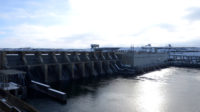Mississippi officials are moving to make emergency repairs at a water treatment plant in Jackson that failed Aug. 29, leaving residents of the state’s capital and largest city with no running water. But the city’s water infrastructure will ultimately need system-wide repairs that could cost billions of dollars, its mayor says.
The O.B. Curtis Water Treatment Plant has a daily capacity of 50 million gallons under normal circumstances. However, the plant had not been operating normally, relying on backup pumps after the two main raw water pumps were damaged in early August, Gov. Tate Reeves said during a press conference. Then, the backup pumps failed on Aug. 29 during a flood of the nearby Pearl River, which caused a total or near-total loss of water pressure throughout Jackson and surrounding areas.
About 180,000 people live in the impacted area, Reeves said.
“Until it's fixed, it means we do not have reliable running water at scale,” Reeves said. “It means the city cannot produce enough water to fight fires, to reliably flush toilets and to meet other critical needs.”
Reeves and the Mississippi State Dept. of Health each issued a state of emergency Aug. 30 over the water crisis. The governor also mobilized the Mississippi National Guard to assist with emergency management efforts. President Joe Biden approved the emergency declaration and authorized the Dept. of Homeland Security and Federal Emergency Management Agency to coordinate disaster relief efforts.
Officials are having tanks of potable and nonpotable water trucked in for residents. But the priority is making repairs to the plant to get water pumping again, Reeves said. State officials created an incident command structure to begin emergency maintenance, repairs and improvements on the facility.
Jim Craig, Mississippi State Dept. of Health senior deputy and director of health protection, said service is being restored as quickly as possible. The plant was back to treating about 30 million gallons Aug. 30 and a rented pump being installed was expected to increase that by another 4 million gallons. However, service was again interrupted early on Aug. 31 when the water entering the plant resulted in a chemical imbalance on one side of the plant, forcing it to temporarily shut down, which further dropped water pressure, he said.
Growing Infrastructure Problems
Jackson’s water infrastructure has faced growing problems for years. Mayor Chokwe Antar Lumumba said during a press conference that the system “has been failing for decades,” but the city has been hampered by a lack of resources. He estimated fixing Jackson’s water distribution problems alone would cost $1 billion, and likely would cost even more.
“I have said on multiple occasions that it’s not a matter of if our system would fail, but a matter of when our system would fail,” Lumumba said.
The city already had a boil-water notice in place for about a month before the treatment plant failure because of cloudiness which could be a sign of disease-causing bacteria in the water.
As ENR previously reported, in February 2021 winter storms froze treatment plant equipment and pipes, leaving thousands of people without water. In parts of the city, the outages lasted nearly five weeks.
Since 2016, tests have shown inadequate treatment chemicals in Jackson’s water, which officials initially attributed to a failing corrosion control system at the Curtis plant. An optimized corrosion control treatment system was installed in 2017, but monitoring has shown the city consistently failed to meet treatment requirements under the U.S. Environmental Protection Agency lead and copper rule into 2022. Jackson also has a second, smaller facility, the J.H. Fewell Water Treatment Plant, where corrosion control installation remains incomplete.
Lumumba said the city had already committed $8 million for a 48-in. water line to south Jackson, which he said was disproportionately affected by the water crisis. The city has also committed millions of dollars more for weatherization of its treatment facilities following the February 2021 crisis.
Jackson also is working to bolster the ranks of its water treatment plant staff, with ten current employees in the midst of required years-long training and certification, Lumumba said. The Curtis plant provides some unusual challenges, as half of it runs on a “conventional” treatment system, and half on a membrane system, he added. Most plants use just one system.
In July 2021, the EPA and city officials reached an agreement setting steps and timeframes for the city to address its long-term drinking water challenges after federal inspectors identified operational and maintenance deficiencies.
Lumumba said the city had “committed every dollar that we could find in order to meet this challenge,” but money for Jackson’s water infrastructure has not historically been readily available. Nearly a quarter of the majority-Black city’s residents live in poverty, according to the U.S. Census Bureau.
Lumumba said the shortage of funding led to maintenance being deferred and allowed problems to accumulate.
That may finally be changing. Since the plant failure, state officials have pledged to cover half the costs of repairs. The White House emergency declaration also makes federal money available.
“The city of Jackson is grateful for the support that we now are receiving from the state,” Lumumba said. “We’ve been going it alone for the better part of two years when it comes to the Jackson water crisis.”
Next Steps
The team working at the plant has so far identified necessary work to come next on the conventional treatment side, Craig said.
Raw water screens must be repaired. Pumps and motors must be replaced. The coagulant system must be restored. Team member also are trying to figure out why sedimentation basins are not draining in a timely manner, he added. The team now is identifying needed improvements on the membrane side, which has had its high-service pumps out of service due to electrical problems.
Reeves warned that sporadic service interruptions would continue as work is performed.






